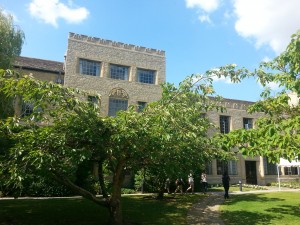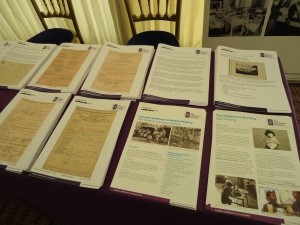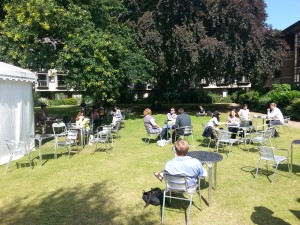Today we have a guest post written by one of our project volunteers, George Cooban.
***
It’s the time of year when lots of us go to the seaside. The case files tell us that many of the children in the care of The Children’s Society in the late-19th and early-20th centuries also visited the coast. But, unlike today, it was often for medical reasons, rather than a holiday.
Previous posts on this blog have highlighted cases where various health conditions led to children spending time by the sea. The coastal convalescent homes run by The Children’s Society at Hurstpierpoint and Broadstairs, established to facilitate the care of sick children sent there, have also been researched in detail. However, I was keen to find out what the case files can tell us about the thinking behind this formerly commonplace practice.
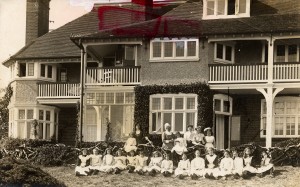
Tuberculosis features very prominently in the case files, and the medical rationale behind the way it was dealt with is often quite clearly recorded. Therefore I decided to focus on cases relating to this condition in this blog post.
***
One thing we notice when examining many of these case files is that seaside convalescent homes were viewed as a means of preventing tuberculosis. (So not all the children who stayed at them were, strictly speaking, convalescent). This is illustrated by reports such as this one, dated 19 June 1910.
“There is a delicate girl aged 13, May [surname], who has been [at the Leamington Home for Girls] for many years, but has to be sent annually to the sea for her health. She probably has a tendency to tuberculosis, but no disease has developed owing to care. She now looks well having just returned from the sea. As she is now at a critical growing and developing age, it would be desirable to move her if possible to Felixstowe before winter for the next two or three years before she goes out. Leamington is relaxing and she needs bracing sea air.”
Another case file contains a medical certificate, written on 7 June 1905, which states that a child, a seven year old girl named Dorothy, has “a tendency towards consumption [tuberculosis]” and recommends moving her to the coast. Later correspondence says that she was treated with a special diet including new laid eggs.
Terms like “delicate” and “a tendency to tuberculosis” appear regularly in the case files. The health of the children referred to in this way was not good, but there is evidence to suggest that sending them to the seaside was seen as a preventative measure, stopping the development of more serious problems.
Several case files, such as those quoted above, give the impression that “sea air” was seen as healthy. But a letter from another case file provides a bit more detail. Dated 3 December 1913, it reports on the condition of a 13 year old girl, Annie, who was staying at St. David’s convalescent home in Broadstairs, Kent:
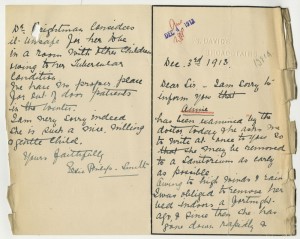
Dec. 3rd. 1913.
Dear Sir – I am sorry to
inform you that
Annie [Surname]
has been examined by the
doctor today & he asks me
to write at once to you so
that she may be removed
to a sanitorium [sic] as early
as possible.
Owing to high winds & rain
I was obliged to remove her
bed indoors a fortnight
ago, & since then she has
gone down rapidly &
Dr. Brightman considers
it unsafe for her to be
in a room with other children
owing to her Tubercular
condition.
We have no proper place
for out of door patients
in the winter.
I am very sorry indeed
she is such a nice, willing
& gentle child.
Yours faithfully
Elsie Philip-Smith
The most surprising thing about this letter is the time of year it was written. It is implied that the only suitable place to treat tuberculosis patients is outdoors, even in winter. Open-air treatment for conditions including tuberculosis was fairly common a century ago. By arranging beds out in the open, as can be seen in the picture from The Children’s Society’s St Martin’s Home in Pyrford below, patients would be exposed to lots of air.
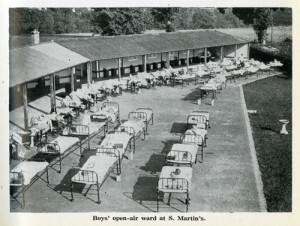
From the letter about Annie we discover that open-air treatment was practiced all year-round. The need for weather which allowed it to take place is also evident. It can be said, in fact, that the weather conditions were of greater importance than how close the patients were to the sea. This is certainly suggested by a letter from another case file. A doctor writing in 1909 advises that a girl “threatened with phthisis [tuberculosis]… would be much benefited by removal to a warmer & more equable climate in the South of England.” Since the girl was living at that time in the St Barnabas’ Home For Girls, New Brighton, Cheshire – a place right by the sea – we can say that sea air on its own was not seen as especially important for health.
The prioritisation of fresh air, together with an “equable climate”, features in medical writing from the time. An article in the British Medical Journal from July 1898, for example, advises that an open-air sanatorium for tuberculosis sufferers should be situated “where the prevailing breezes sweep over the sea, or over moorland, or, better still, where these two conditions are associated, and fresh, pure air comes from all quarters of the compass.”
Similar thinking appears in another case file. A doctor’s report from 1927 on a 16 year old boy, Leslie, who had been working at The Children’s Society’s head office in London, states that he is “obviously predisposed to tuberculosis, especially as he works in London”, and recommends for him “an outdoor occupation, preferably in the country or at sea, as this will probably prevent any active tuberculosis developing”. The Society helped Leslie find work as a steward on the SS Baltic. This was quite different to the career previously envisaged for him: earlier correspondence highlights Leslie’s aptitude for draughtsmanship.
This case, like the others, shows the impact contemporary medical opinion had on the lives of children who had tuberculosis or were at risk of contracting it. Nowadays the condition can be treated with antibiotics. But a century ago the dangers were much greater, and the response was often to move children long distances for the good of their health, even if they were only considered susceptible to tuberculosis.
At a time when urban air pollution in Britain was severe, sea air was valued for its quality. However, simply being by the coast was not essential: the objective was fresh air. But the convalescent homes established on the coast did offer other benefits besides sea air. The staff were better trained to look after children with health problems. There were opportunities for the children to get exercise, which may have been limited in more urban homes. There is also evidence in some case files that children were given more or better food to build them up while they were staying in the convalescent homes. Finally, a modern study has suggested that there may be health benefits to be gained from living on the coast, but they are psychological ones, and not related to the air there. The case files show that, in the absence of today’s more effective treatments, a proactive approach to tuberculosis was taken, and this surely saved many lives.
Want to find out more?
Click here to read another blog post on sea air and health, featuring a case where the avoidance of sea air was recommended.
Historic articles from the British Medical Journal discussing open-air treatment of tubercular cases can be found here: http://www.bmj.com/archive

